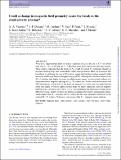Files in this item
Could a change in magnetic field geometry cause the break in the wind-activity relation?
Item metadata
| dc.contributor.author | Vidotto, Aline | |
| dc.contributor.author | Donati, J.-F. | |
| dc.contributor.author | Jardine, Moira Mary | |
| dc.contributor.author | See, Wyke Chun Victor | |
| dc.contributor.author | Petit, P. | |
| dc.contributor.author | Boisse, I. | |
| dc.contributor.author | Boro Saikia, S. | |
| dc.contributor.author | Hébrard, E. | |
| dc.contributor.author | Jeffers, Sandra Victoria | |
| dc.contributor.author | Marsden, S. C. | |
| dc.contributor.author | Morin, J. | |
| dc.date.accessioned | 2016-02-24T15:10:14Z | |
| dc.date.available | 2016-02-24T15:10:14Z | |
| dc.date.issued | 2016-01-01 | |
| dc.identifier | 241204787 | |
| dc.identifier | ff17d601-f95d-4f13-8fed-a0007f5fa186 | |
| dc.identifier | 85052576493 | |
| dc.identifier | 000368005900012 | |
| dc.identifier.citation | Vidotto , A , Donati , J-F , Jardine , M M , See , W C V , Petit , P , Boisse , I , Boro Saikia , S , Hébrard , E , Jeffers , S V , Marsden , S C & Morin , J 2016 , ' Could a change in magnetic field geometry cause the break in the wind-activity relation? ' , Monthly Notices of the Royal Astronomical Society: Letters , vol. 455 , no. 1 , pp. L52–L56 . https://doi.org/10.1093/mnrasl/slv147 | en |
| dc.identifier.issn | 1745-3925 | |
| dc.identifier.other | BibCode: 2016MNRAS.455L..52V | |
| dc.identifier.other | ORCID: /0000-0002-1466-5236/work/57821830 | |
| dc.identifier.uri | https://hdl.handle.net/10023/8305 | |
| dc.description | AAV acknowledges support from the Swiss National Science Foundation through an Ambizione Fellowship. SVJ and SBS acknowledge research funding by the Deutsche Forschungsgemeinschaft under grant SFB 963/1, project A16. | en |
| dc.description.abstract | Wood et al. suggested that mass-loss rate is a function of X-ray flux (dot{M}∝ F_x^{1.34}) for dwarf stars with Fx ≲ Fx,6 ≡ 106 erg cm-2 s-1. However, more active stars do not obey this relation. These authors suggested that the break at Fx,6 could be caused by significant changes in magnetic field topology that would inhibit stellar wind generation. Here, we investigate this hypothesis by analysing the stars in Wood et al. sample that had their surface magnetic fields reconstructed through Zeeman-Doppler Imaging (ZDI). Although the solar-like outliers in the dot{M} - Fx relation have higher fractional toroidal magnetic energy, we do not find evidence of a sharp transition in magnetic topology at Fx,6. To confirm this, further wind measurements and ZDI observations at both sides of the break are required. As active stars can jump between states with highly toroidal to highly poloidal fields, we expect significant scatter in magnetic field topology to exist for stars with Fx ≳ Fx,6. This strengthens the importance of multi-epoch ZDI observations. Finally, we show that there is a correlation between Fx and magnetic energy, which implies that dot{M} - magnetic energy relation has the same qualitative behaviour as the original dot{M} - Fx relation. No break is seen in any of the Fx - magnetic energy relations. | |
| dc.format.extent | 437937 | |
| dc.language.iso | eng | |
| dc.relation.ispartof | Monthly Notices of the Royal Astronomical Society: Letters | en |
| dc.subject | Magnetic fields | en |
| dc.subject | Stars: activity | en |
| dc.subject | Stars: coronae | en |
| dc.subject | Stars: low-mass | en |
| dc.subject | Stars: winds | en |
| dc.subject | Outflows | en |
| dc.subject | QB Astronomy | en |
| dc.subject | QC Physics | en |
| dc.subject | 3rd-DAS | en |
| dc.subject.lcc | QB | en |
| dc.subject.lcc | QC | en |
| dc.title | Could a change in magnetic field geometry cause the break in the wind-activity relation? | en |
| dc.type | Journal article | en |
| dc.contributor.sponsor | Science & Technology Facilities Council | en |
| dc.contributor.institution | University of St Andrews. School of Physics and Astronomy | en |
| dc.identifier.doi | 10.1093/mnrasl/slv147 | |
| dc.description.status | Peer reviewed | en |
| dc.identifier.url | http://adsabs.harvard.edu/abs/2016MNRAS.455L..52V | en |
| dc.identifier.url | http://mnrasl.oxfordjournals.org/content/455/1/L52/suppl/DC1 | en |
| dc.identifier.grantnumber | ST/M001296/1 | en |
This item appears in the following Collection(s)
Items in the St Andrews Research Repository are protected by copyright, with all rights reserved, unless otherwise indicated.

